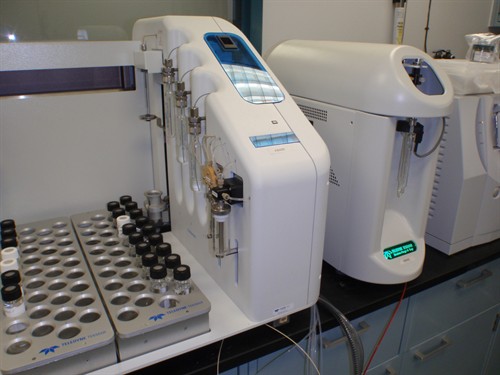Lab Services
American Bottoms Regional Wastewater Treatment Facility possesses a laboratory that is accredited by the Illinois Environmental Protection Agency (IEPA) for environmental testing.
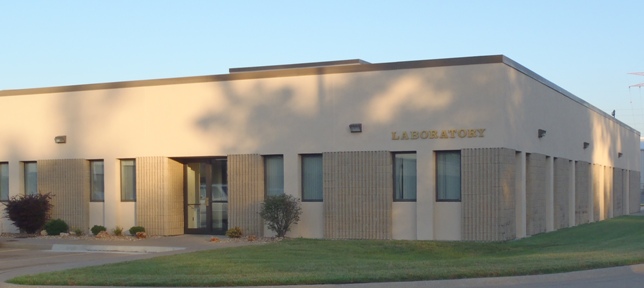
The laboratory is certified for many EPA approved analyses for wastewater, groundwater and solid waste. If you have testing required by your permit, or for specific project needs, please contact us for more information to see if American Bottoms can manage your analytical requirements.
The American Bottoms Laboratory
The Illinois Environmental Protection Agency (IEPA) has granted the American Bottoms Laboratory a certification to perform environmental testing through the nationally recognized TNI (The NELAC Institute) organization.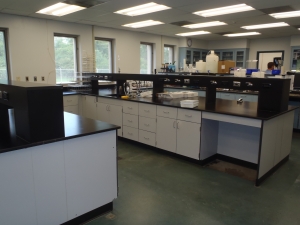
The certification includes a rigorous Quality Assurance/Quality Control (QA/QC) system, proficiency testing of each certified analysis, and audits every two years from the IEPA. The laboratory has been an accredited since 2002.
The laboratory has business hours of 7:30 am – 4:00 pm, Monday through Friday. Our turnaround time is typically 10 business days, depending on the analysis. Quicker turnaround may be performed, if requested, for a fee. If you have sampling questions regarding sample containers, preservatives, or type of sample, please contact us.
Customers
New customers include companies that haul wastewater, new local industries, other wastewater plants, or those in the region who desire a method compliant analysis from a TNI accredited laboratory.
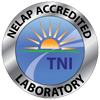
For hauled wastewater customers, the American Bottoms Operations department will retrieve and transport the samples from the wastewater delivery. The laboratory will analyze what is requested based upon the Hauler’s agreement. For external sample locations, the laboratory accepts deliveries during the work week.
The testing normally performed in the laboratory provides data for 1) Compliance, 2) Pretreatment, 3) Operations, 4) Hauled Wastewater, or 5) billing purposes. We also perform many tests as part of special studies that are non-routine. If we do not perform the testing in-house, we subcontract to another TNI accredited laboratory that can perform the requested tests.
A Titration of a Plant Sample Using Color Indicator to Test for Organic and Ammonia-Nitrogen
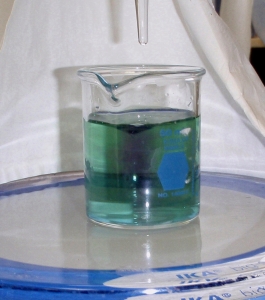
Analytical
The types of samples, or matrices, that we analyze include wastewater, groundwater, and solid waste material. For clarity, the tests are organized into the following types on the Analyses page:
1) Conventional Wastewater Analyses
Conventional wastewater analyses include:
|
|
|
These tests are typically needed for either compliance and/or operational monitoring.
2) Metals and Organic Analyses
The metals parameters include testing for the following:
|
|
|
The analysis of metals provides useful information for many aspects of the company including: insight into the removal efficiency of the treatment plant, for billing needs, and also compliance and pretreatment. The testing for organic chemicals is primarily driven by pretreatment and compliance, but also for operational data. Each organic analysis, which includes volatile organic and semi-volatile organic compounds, includes a lengthy list of calibrated compounds.
3) Toxic Characteristic Leaching Procedure (TCLP) Analyses
The TCLP procedure is used to extract the parameters found in a solid matrix sample to a liquid or extract. The results from the analysis on the extract are compared to the EPA regulatory level to determine if the sample is hazardous or non-hazardous.
An Instrument with an Auto-Sampler Unit that Detects Volatile Organic Compounds (Such as Benzene and Toluene)
Laboratory Mission
Most important for the laboratory is to follow the Mission of American Bottoms as we perform the needed tasks to accomplish our goals: we must be safe, which means proper personal protective equipment (safety glasses, protective gloves, lab coats, etc), thorough training, and working at a pace which allows for secure handling of potentially hazardous chemicals and containers; we must provide EPA approved, method compliant data to the customers for confidence in the final results and to meet EPA requirements. By meeting the EPA sampling and analysis requirements, the data may be used for our permit and those permits that we provide data for; finally, we strive to be cost effective by continually pushing each other to think of smarter ways to purchase supplies, perform analyses, and utilize professional contractors.

